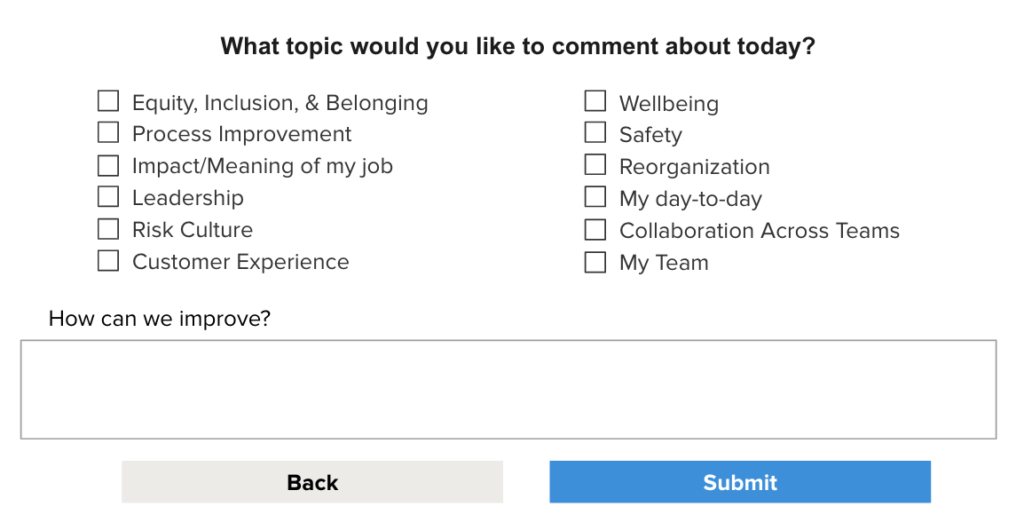Turn your employee experience (EX) program’s focus to your people — here’s how to identify what matters to employees as you ask for and listen to their feedback.
Building an employee experience program is a task that requires time, effort, and resources to ensure long-term success.
Leaders often ask, “What questions should we ask in our employee surveys?” In response, I typically explain that it depends and then inquire about what they actually want to learn from their people, which leads to a discussion about organizations wanting to know what they’re doing right and what they need to do to improve.
The ‘why’ behind leaders’ motivation to plan, build, and launch a robust EX program comes from wanting to know what their people care about most so they can make sure they’re doing those things really well.
While there isn’t a one-size-fits-all approach to achieving success, organizations across every industry should closely follow one simple rule as they take action: ask and listen. EX programs are designed to tap into employee sentiment, and listening to your people is just as critical as asking them for their feedback.
Here are several options to consider for identifying and understanding what actually matters to employees.
Uncover What Matters to Employees Using Insights in Existing Data: The Approaches to Analyzing Feedback
You may already have an existing and active feedback program or a type of employee survey such as engagement, recruiting and onboarding, well-being, and diversity, equity, inclusion, and belonging (DEIB). If so, you’re already on the right path and are sitting on a wealth of information. If you haven’t built out an EX program yet or the data available to you isn’t particularly recent, it’s not too late to capture new feedback and get a clear pulse on current perspectives.
Employee surveys traditionally capture feedback through questions with rating scales, which in turn produce numeric or quantitative results, and open-ended questions, which allow employees to provide written feedback. Have this type of data? You can take one of two approaches to analyzing employee feedback.
EX leaders can dig into feedback using a traditional approach or a progressive approach. With the traditional approach, you’re focused on reviewing quantitative results. Take a progressive approach, however, and you’ll turn your attention to identifying core themes and sentiments in qualitative feedback.
Let’s explain the traditional and progressive approaches in more detail.
Traditional Approach to Analyzing Employee Feedback
When reviewing quantitative results, you’re able to identify what matters most to your people by not only looking at which survey items receive the highest and lowest ratings but also by focusing on driver (or ‘impact’) scores.
Modern survey platforms provide driver scores that correlate employees’ responses to individual questions — such as, “I feel deeply connected to our company’s mission” — with a specific outcome metric such as engagement or belonging. High and low rating scores can generally indicate what your people are feeling good or not so good about, but driver scores help uncover which items are most strongly related to the outcome of interest.
In other words, driver scores tell you specifically what your people care about most and where you have the most leverage to improve the employee experience.
Progressive Approach to Analyzing Employee Feedback
Open-ended questions render a great deal of valuable information, and it’s all in your employees’ words.
Comments may be associated with specific, targeted questions from the survey or general questions that allow an employee to speak exactly how they feel necessary — the latter of which is a question like, “What do you think our company could be doing better right now?”
If you work in a relatively large organization, you might cringe at the thought of having to read through and summarize every word of unstructured feedback from open-ended questions. I can’t blame you for feeling that way, but there’s good news: the most effective experience management platforms offer advanced text analytics capabilities to organize and categorize feedback into high-level topics and themes automatically.
You’ll also see sentiment — whether positive, neutral, or negative — associated with each topic of interest so you understand both the topics your people are talking about and how exactly they feel about them.
Everything should come together in a platform that provides driver scores based on ratings, from the traditional approach to analyzing employee feedback, with the progressive approach’s themes so you recognize how people feel and why they’re feeling that way. Aligning the traditional and progressive approaches to understanding employee feedback is useful for monitoring metrics such as retention and well-being.
Solicit & Understand Employee Feedback When It Matters Most to Your People
Tailor your employee experience program to capture feedback at the right time and in the most appropriate format to encourage more responses, using triggered surveys and a freestyle-like format.
Triggered Feedback
As mentioned earlier, organizations have the opportunity to listen more frequently and during other important moments — all by triggering surveys during critical events such as when an employee transfers to a new role or team, when their manager changes, or even when their shift or work schedule changes significantly.
Moments like these create stress (or, hopefully, excitement) for employees, and triggered surveys surface in real-time how an employee feels, what they need to feel supported and be successful, and what’s top of mind for them. It allows your organization to act before an overwhelmed employee feels unheard and ultimately decides to leave the company.
Triggered surveys can be launched as moments occur, or you can introduce monthly pulse surveys on specific topics of interest.
‘Choose Your Own Adventure’ (or ‘Anytime’) Feedback
One of the most effective approaches to understanding what matters to your employees is what we refer to as a ‘Choose Your Own Adventure’ (or ‘Anytime’) survey.
Anytime surveys are available to employees 24/7 to provide their thoughts on a specific topic that the organization may or may not be focused on. It’s not about what the organization wants to hear about — instead, surveys like these provide an open microphone of sorts for employees to share feedback as soon as they choose to do so.
Organizations may be surprised by what they’ll learn through ‘Choose Your Own Adventure’ feedback, and setting up this type of feedback mechanism is easy. You just need the right technology to capture employee feedback and share it with the right leader(s) depending on what topic or issue the feedback is about; not everything needs to go to the human resources (HR) department.
Routing insights to the department or person that can act on them is critical. Here’s an example:

Employees can access a survey like this almost anywhere in an organization, from a homepage of an intranet such as Highspot to a QR code or automated Slack message. What’s important is that employees know it’s there, can access it easily, and see action being taken from the feedback, so be sure to over-communicate what you’re learning and how you’re making improvements to what matters to employees.
Listen to Employee Feedback & Make Impactful Improvements to the Workplace
By enabling employees to provide you with their thoughts, concerns, and ideas, your organization further empowers leaders to view feedback in the moment while also identifying trends — all of which helps EX leaders understand what matters to employees to make improvements that increase satisfaction, elevate performance, and retain top performers.
Preparing an EX program within your organization? Check out Expert Insights: The Ultimate Guide to Building an Employee Experience Program, a step-by-step playbook with insights from leaders who have firsthand experience launching and advancing programs that drive results.








